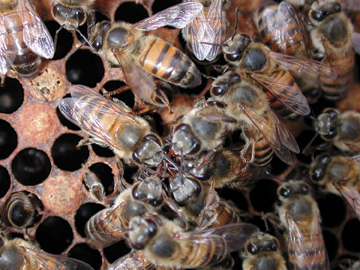After more than 10 years of searching, researchers have identified a compound produced by the senior workers in a honeybee colony that prolongs the time that teenage bees stay home babysitting.

Honeybee workers spend their first few weeks as young adults tending the colony’s brood and then shift jobs to foraging for food outside the colony. Studies had predicted that established foragers pass along a pheromone that slows their younger sisters’ career change, according to Gene E. Robinson of the University of Illinois at Urbana-Champaign.
That pheromone turns out to include ethyl oleate, possibly conveyed to the teens during mouth-to-mouth food transfer, Robinson and an international team of colleagues report in an upcoming Proceedings of the National Academy of Sciences.
The pheromone guides the division of labor. “When we think about this with a human bias, it seems like a problem that requires centralized control. But it’s decentralized,” says Robinson. Should the colony run low on mature foragers, the supply of grow-slow pheromone dwindles, and young bees mature rapidly to fill in the ranks. When foragers abound, an abundance of the pheromone slows the replacement process.
Bee researcher Francis Ratnieks of the University of Sheffield in England compares organizing colony tasks to “directing traffic through New York City. It’s a never-ending challenge, and weird things are always happening.” Commenting on the new study, he notes that more than 20 previously identified bee-to-bee signals transfer information chemically or mechanically. Bee dances are famous, but another signal is “a bee standing on top of another bee and giving it a good shaking,” he adds.
The earlier tests that had predicted a grow-slow pheromone included, for example, one study finding fast maturation of youngsters within a colony stripped of its foragers. Other experiments that separated younger and older workers with screens suggested that the pheromone spreads by contact rather than airflow.
At least five lines of chemical inquiry dead-ended before the researchers focused on ethyl oleate as a potential pheromone component, Robinson says. They eventually noted that foragers carry some 30 times as much of the chemical as younger bees do.
The researchers fed candy laced with ethyl oleate to bees from two of three age-matched colonies. Young bees eating spiked candy turned to foraging later than those eating plain candy did.
Ben Oldroyd, a bee specialist at the University of Sydney in Australia, calls the work “a step forward, mainly because of the experimental opportunities it offers.” He says he’d like to find out how ethyl oleate influences gene expression and hormone activity.
Robinson and other scientists note that the grow-slow pheromone probably contains ingredients besides ethyl oleate. Tanya Pankiw of Texas A&M University in College Station says that experiments in her lab indicate that at least four compounds from foragers affect maturation of other bees. She cautions that genetic makeup and environmental factors also influence foraging.






